International Intercultural Management: Cultural Differences Report
VerifiedAdded on 2023/02/06
|18
|4781
|30
Report
AI Summary
This report provides an in-depth analysis of international intercultural management, focusing on the cultural differences between the UK and the US and their impact on business. It begins with an introduction to the importance of understanding culture in a globalized world, followed by an exploration of relevant theoretical frameworks, including the Iceberg cultural model, the Geert Hofstede cultural framework, and the Lewis Model. The report uses the Tesco Company's expansion into the US as a case study to illustrate the practical implications of these frameworks. It examines the distinct cultural values and norms of both countries, such as individualism versus collectivism, and the impact on business practices. The report analyzes the dimensions of culture and how they influence consumer behavior, communication styles, and organizational structures. The report concludes with recommendations for businesses operating in international markets, emphasizing the need for cultural sensitivity and adaptation to ensure success. The report highlights that the cultural understanding is crucial for multinational corporations to succeed in foreign markets.
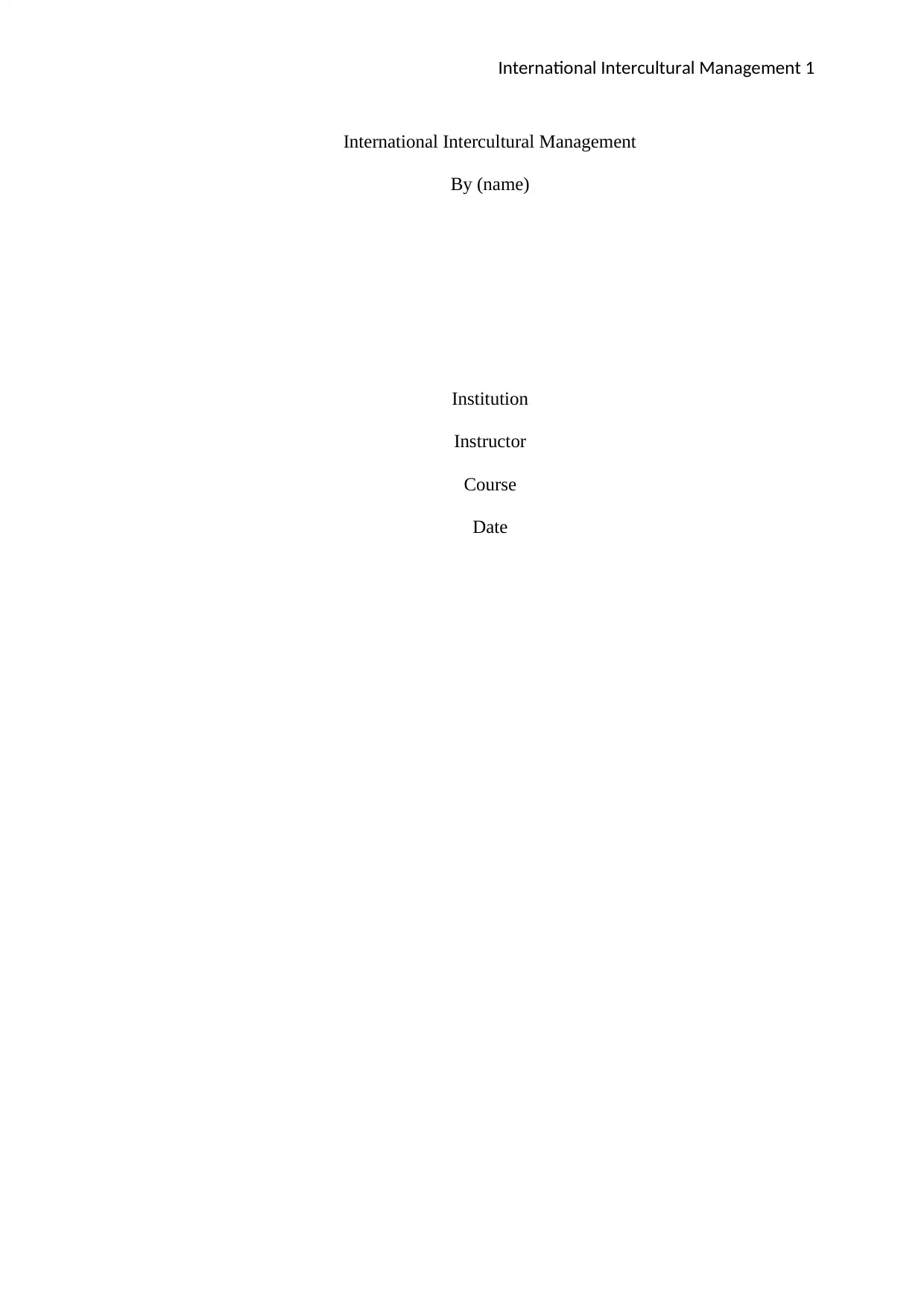
International Intercultural Management 1
International Intercultural Management
By (name)
Institution
Instructor
Course
Date
International Intercultural Management
By (name)
Institution
Instructor
Course
Date
Paraphrase This Document
Need a fresh take? Get an instant paraphrase of this document with our AI Paraphraser
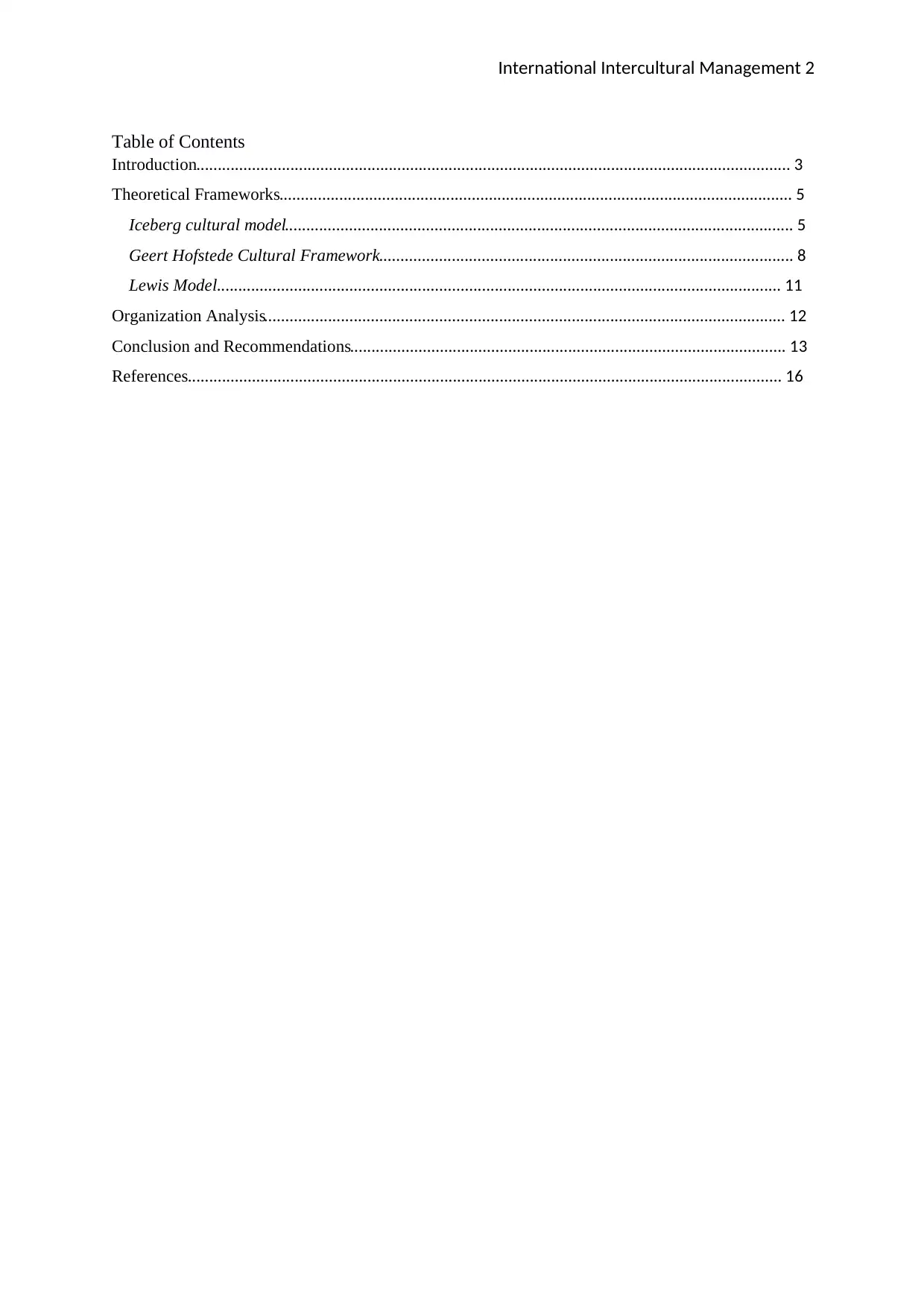
International Intercultural Management 2
Table of Contents
Introduction........................................................................................................................................... 3
Theoretical Frameworks........................................................................................................................ 5
Iceberg cultural model....................................................................................................................... 5
Geert Hofstede Cultural Framework................................................................................................. 8
Lewis Model.................................................................................................................................... 11
Organization Analysis.......................................................................................................................... 12
Conclusion and Recommendations...................................................................................................... 13
References........................................................................................................................................... 16
Table of Contents
Introduction........................................................................................................................................... 3
Theoretical Frameworks........................................................................................................................ 5
Iceberg cultural model....................................................................................................................... 5
Geert Hofstede Cultural Framework................................................................................................. 8
Lewis Model.................................................................................................................................... 11
Organization Analysis.......................................................................................................................... 12
Conclusion and Recommendations...................................................................................................... 13
References........................................................................................................................................... 16
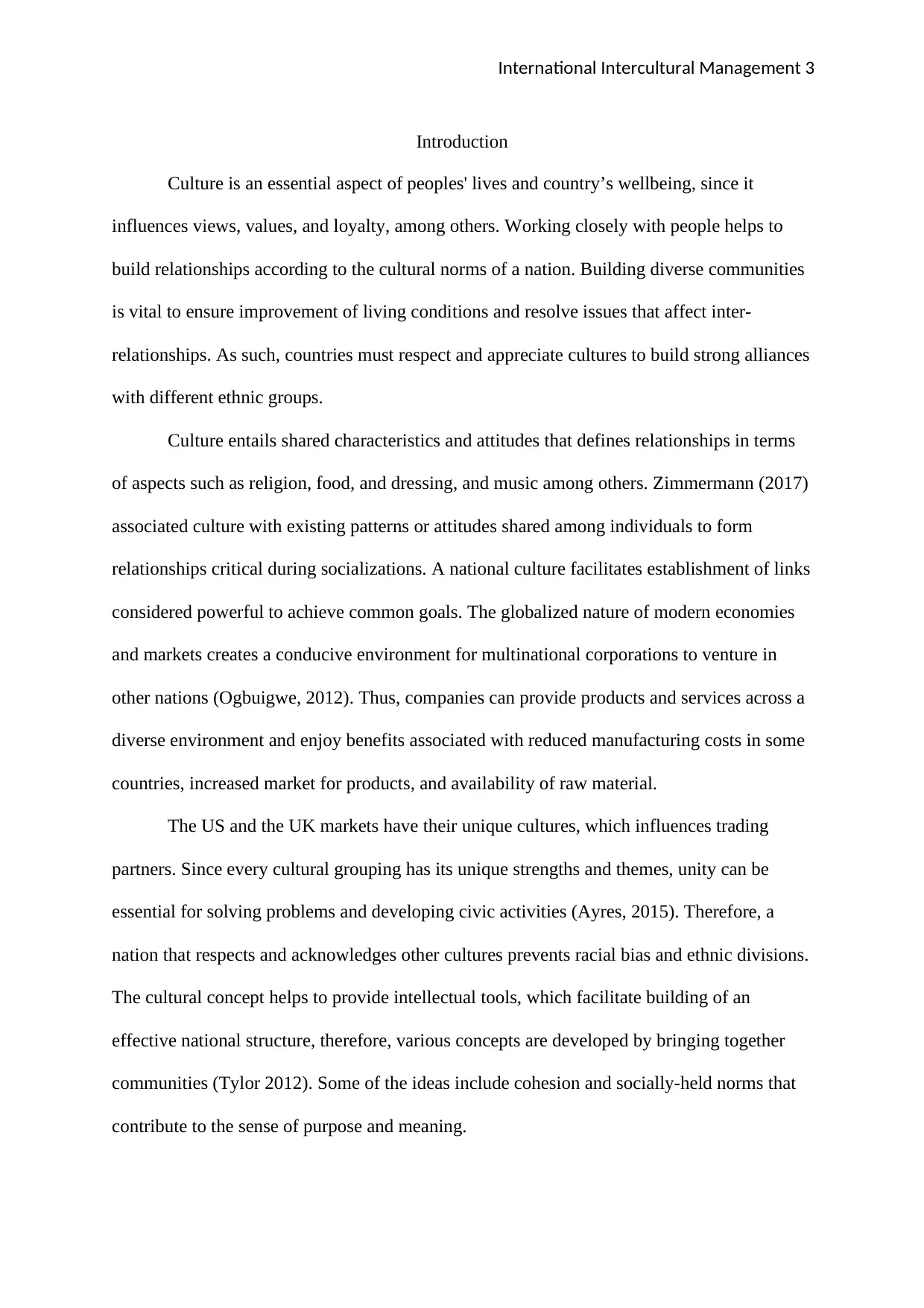
International Intercultural Management 3
Introduction
Culture is an essential aspect of peoples' lives and country’s wellbeing, since it
influences views, values, and loyalty, among others. Working closely with people helps to
build relationships according to the cultural norms of a nation. Building diverse communities
is vital to ensure improvement of living conditions and resolve issues that affect inter-
relationships. As such, countries must respect and appreciate cultures to build strong alliances
with different ethnic groups.
Culture entails shared characteristics and attitudes that defines relationships in terms
of aspects such as religion, food, and dressing, and music among others. Zimmermann (2017)
associated culture with existing patterns or attitudes shared among individuals to form
relationships critical during socializations. A national culture facilitates establishment of links
considered powerful to achieve common goals. The globalized nature of modern economies
and markets creates a conducive environment for multinational corporations to venture in
other nations (Ogbuigwe, 2012). Thus, companies can provide products and services across a
diverse environment and enjoy benefits associated with reduced manufacturing costs in some
countries, increased market for products, and availability of raw material.
The US and the UK markets have their unique cultures, which influences trading
partners. Since every cultural grouping has its unique strengths and themes, unity can be
essential for solving problems and developing civic activities (Ayres, 2015). Therefore, a
nation that respects and acknowledges other cultures prevents racial bias and ethnic divisions.
The cultural concept helps to provide intellectual tools, which facilitate building of an
effective national structure, therefore, various concepts are developed by bringing together
communities (Tylor 2012). Some of the ideas include cohesion and socially-held norms that
contribute to the sense of purpose and meaning.
Introduction
Culture is an essential aspect of peoples' lives and country’s wellbeing, since it
influences views, values, and loyalty, among others. Working closely with people helps to
build relationships according to the cultural norms of a nation. Building diverse communities
is vital to ensure improvement of living conditions and resolve issues that affect inter-
relationships. As such, countries must respect and appreciate cultures to build strong alliances
with different ethnic groups.
Culture entails shared characteristics and attitudes that defines relationships in terms
of aspects such as religion, food, and dressing, and music among others. Zimmermann (2017)
associated culture with existing patterns or attitudes shared among individuals to form
relationships critical during socializations. A national culture facilitates establishment of links
considered powerful to achieve common goals. The globalized nature of modern economies
and markets creates a conducive environment for multinational corporations to venture in
other nations (Ogbuigwe, 2012). Thus, companies can provide products and services across a
diverse environment and enjoy benefits associated with reduced manufacturing costs in some
countries, increased market for products, and availability of raw material.
The US and the UK markets have their unique cultures, which influences trading
partners. Since every cultural grouping has its unique strengths and themes, unity can be
essential for solving problems and developing civic activities (Ayres, 2015). Therefore, a
nation that respects and acknowledges other cultures prevents racial bias and ethnic divisions.
The cultural concept helps to provide intellectual tools, which facilitate building of an
effective national structure, therefore, various concepts are developed by bringing together
communities (Tylor 2012). Some of the ideas include cohesion and socially-held norms that
contribute to the sense of purpose and meaning.
⊘ This is a preview!⊘
Do you want full access?
Subscribe today to unlock all pages.

Trusted by 1+ million students worldwide
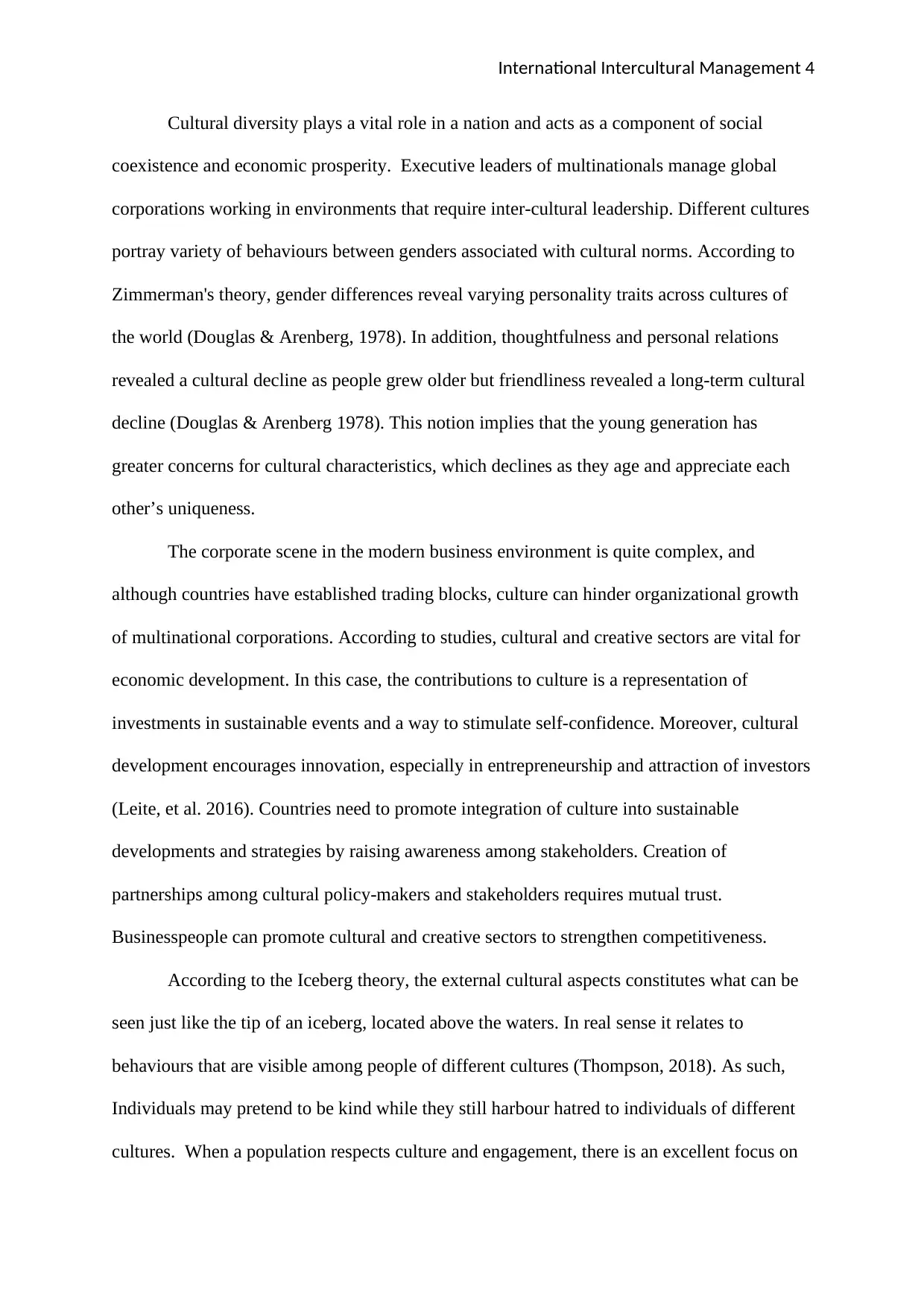
International Intercultural Management 4
Cultural diversity plays a vital role in a nation and acts as a component of social
coexistence and economic prosperity. Executive leaders of multinationals manage global
corporations working in environments that require inter-cultural leadership. Different cultures
portray variety of behaviours between genders associated with cultural norms. According to
Zimmerman's theory, gender differences reveal varying personality traits across cultures of
the world (Douglas & Arenberg, 1978). In addition, thoughtfulness and personal relations
revealed a cultural decline as people grew older but friendliness revealed a long-term cultural
decline (Douglas & Arenberg 1978). This notion implies that the young generation has
greater concerns for cultural characteristics, which declines as they age and appreciate each
other’s uniqueness.
The corporate scene in the modern business environment is quite complex, and
although countries have established trading blocks, culture can hinder organizational growth
of multinational corporations. According to studies, cultural and creative sectors are vital for
economic development. In this case, the contributions to culture is a representation of
investments in sustainable events and a way to stimulate self-confidence. Moreover, cultural
development encourages innovation, especially in entrepreneurship and attraction of investors
(Leite, et al. 2016). Countries need to promote integration of culture into sustainable
developments and strategies by raising awareness among stakeholders. Creation of
partnerships among cultural policy-makers and stakeholders requires mutual trust.
Businesspeople can promote cultural and creative sectors to strengthen competitiveness.
According to the Iceberg theory, the external cultural aspects constitutes what can be
seen just like the tip of an iceberg, located above the waters. In real sense it relates to
behaviours that are visible among people of different cultures (Thompson, 2018). As such,
Individuals may pretend to be kind while they still harbour hatred to individuals of different
cultures. When a population respects culture and engagement, there is an excellent focus on
Cultural diversity plays a vital role in a nation and acts as a component of social
coexistence and economic prosperity. Executive leaders of multinationals manage global
corporations working in environments that require inter-cultural leadership. Different cultures
portray variety of behaviours between genders associated with cultural norms. According to
Zimmerman's theory, gender differences reveal varying personality traits across cultures of
the world (Douglas & Arenberg, 1978). In addition, thoughtfulness and personal relations
revealed a cultural decline as people grew older but friendliness revealed a long-term cultural
decline (Douglas & Arenberg 1978). This notion implies that the young generation has
greater concerns for cultural characteristics, which declines as they age and appreciate each
other’s uniqueness.
The corporate scene in the modern business environment is quite complex, and
although countries have established trading blocks, culture can hinder organizational growth
of multinational corporations. According to studies, cultural and creative sectors are vital for
economic development. In this case, the contributions to culture is a representation of
investments in sustainable events and a way to stimulate self-confidence. Moreover, cultural
development encourages innovation, especially in entrepreneurship and attraction of investors
(Leite, et al. 2016). Countries need to promote integration of culture into sustainable
developments and strategies by raising awareness among stakeholders. Creation of
partnerships among cultural policy-makers and stakeholders requires mutual trust.
Businesspeople can promote cultural and creative sectors to strengthen competitiveness.
According to the Iceberg theory, the external cultural aspects constitutes what can be
seen just like the tip of an iceberg, located above the waters. In real sense it relates to
behaviours that are visible among people of different cultures (Thompson, 2018). As such,
Individuals may pretend to be kind while they still harbour hatred to individuals of different
cultures. When a population respects culture and engagement, there is an excellent focus on
Paraphrase This Document
Need a fresh take? Get an instant paraphrase of this document with our AI Paraphraser
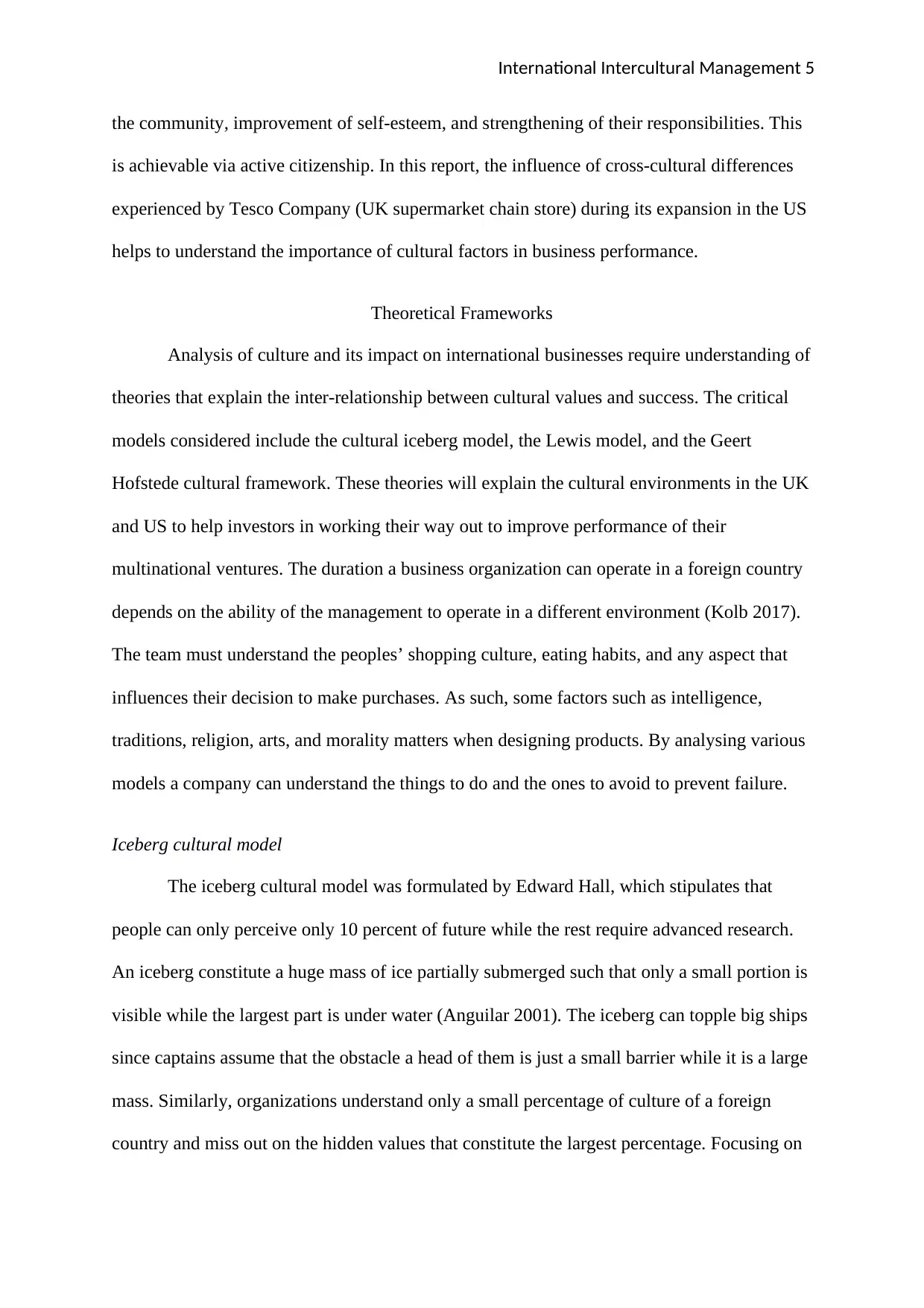
International Intercultural Management 5
the community, improvement of self-esteem, and strengthening of their responsibilities. This
is achievable via active citizenship. In this report, the influence of cross-cultural differences
experienced by Tesco Company (UK supermarket chain store) during its expansion in the US
helps to understand the importance of cultural factors in business performance.
Theoretical Frameworks
Analysis of culture and its impact on international businesses require understanding of
theories that explain the inter-relationship between cultural values and success. The critical
models considered include the cultural iceberg model, the Lewis model, and the Geert
Hofstede cultural framework. These theories will explain the cultural environments in the UK
and US to help investors in working their way out to improve performance of their
multinational ventures. The duration a business organization can operate in a foreign country
depends on the ability of the management to operate in a different environment (Kolb 2017).
The team must understand the peoples’ shopping culture, eating habits, and any aspect that
influences their decision to make purchases. As such, some factors such as intelligence,
traditions, religion, arts, and morality matters when designing products. By analysing various
models a company can understand the things to do and the ones to avoid to prevent failure.
Iceberg cultural model
The iceberg cultural model was formulated by Edward Hall, which stipulates that
people can only perceive only 10 percent of future while the rest require advanced research.
An iceberg constitute a huge mass of ice partially submerged such that only a small portion is
visible while the largest part is under water (Anguilar 2001). The iceberg can topple big ships
since captains assume that the obstacle a head of them is just a small barrier while it is a large
mass. Similarly, organizations understand only a small percentage of culture of a foreign
country and miss out on the hidden values that constitute the largest percentage. Focusing on
the community, improvement of self-esteem, and strengthening of their responsibilities. This
is achievable via active citizenship. In this report, the influence of cross-cultural differences
experienced by Tesco Company (UK supermarket chain store) during its expansion in the US
helps to understand the importance of cultural factors in business performance.
Theoretical Frameworks
Analysis of culture and its impact on international businesses require understanding of
theories that explain the inter-relationship between cultural values and success. The critical
models considered include the cultural iceberg model, the Lewis model, and the Geert
Hofstede cultural framework. These theories will explain the cultural environments in the UK
and US to help investors in working their way out to improve performance of their
multinational ventures. The duration a business organization can operate in a foreign country
depends on the ability of the management to operate in a different environment (Kolb 2017).
The team must understand the peoples’ shopping culture, eating habits, and any aspect that
influences their decision to make purchases. As such, some factors such as intelligence,
traditions, religion, arts, and morality matters when designing products. By analysing various
models a company can understand the things to do and the ones to avoid to prevent failure.
Iceberg cultural model
The iceberg cultural model was formulated by Edward Hall, which stipulates that
people can only perceive only 10 percent of future while the rest require advanced research.
An iceberg constitute a huge mass of ice partially submerged such that only a small portion is
visible while the largest part is under water (Anguilar 2001). The iceberg can topple big ships
since captains assume that the obstacle a head of them is just a small barrier while it is a large
mass. Similarly, organizations understand only a small percentage of culture of a foreign
country and miss out on the hidden values that constitute the largest percentage. Focusing on
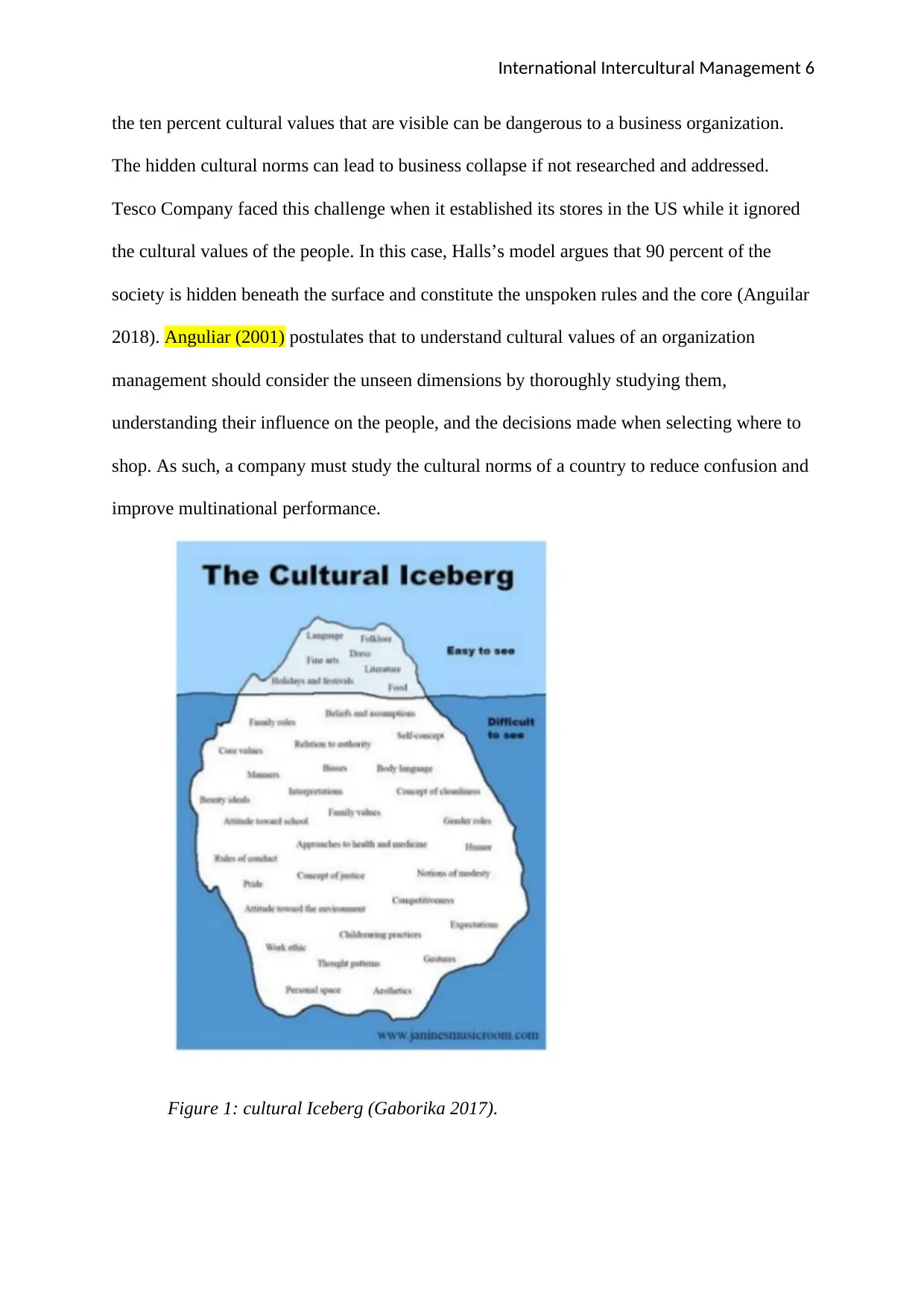
International Intercultural Management 6
the ten percent cultural values that are visible can be dangerous to a business organization.
The hidden cultural norms can lead to business collapse if not researched and addressed.
Tesco Company faced this challenge when it established its stores in the US while it ignored
the cultural values of the people. In this case, Halls’s model argues that 90 percent of the
society is hidden beneath the surface and constitute the unspoken rules and the core (Anguilar
2018). Anguliar (2001) postulates that to understand cultural values of an organization
management should consider the unseen dimensions by thoroughly studying them,
understanding their influence on the people, and the decisions made when selecting where to
shop. As such, a company must study the cultural norms of a country to reduce confusion and
improve multinational performance.
Figure 1: cultural Iceberg (Gaborika 2017).
the ten percent cultural values that are visible can be dangerous to a business organization.
The hidden cultural norms can lead to business collapse if not researched and addressed.
Tesco Company faced this challenge when it established its stores in the US while it ignored
the cultural values of the people. In this case, Halls’s model argues that 90 percent of the
society is hidden beneath the surface and constitute the unspoken rules and the core (Anguilar
2018). Anguliar (2001) postulates that to understand cultural values of an organization
management should consider the unseen dimensions by thoroughly studying them,
understanding their influence on the people, and the decisions made when selecting where to
shop. As such, a company must study the cultural norms of a country to reduce confusion and
improve multinational performance.
Figure 1: cultural Iceberg (Gaborika 2017).
⊘ This is a preview!⊘
Do you want full access?
Subscribe today to unlock all pages.

Trusted by 1+ million students worldwide
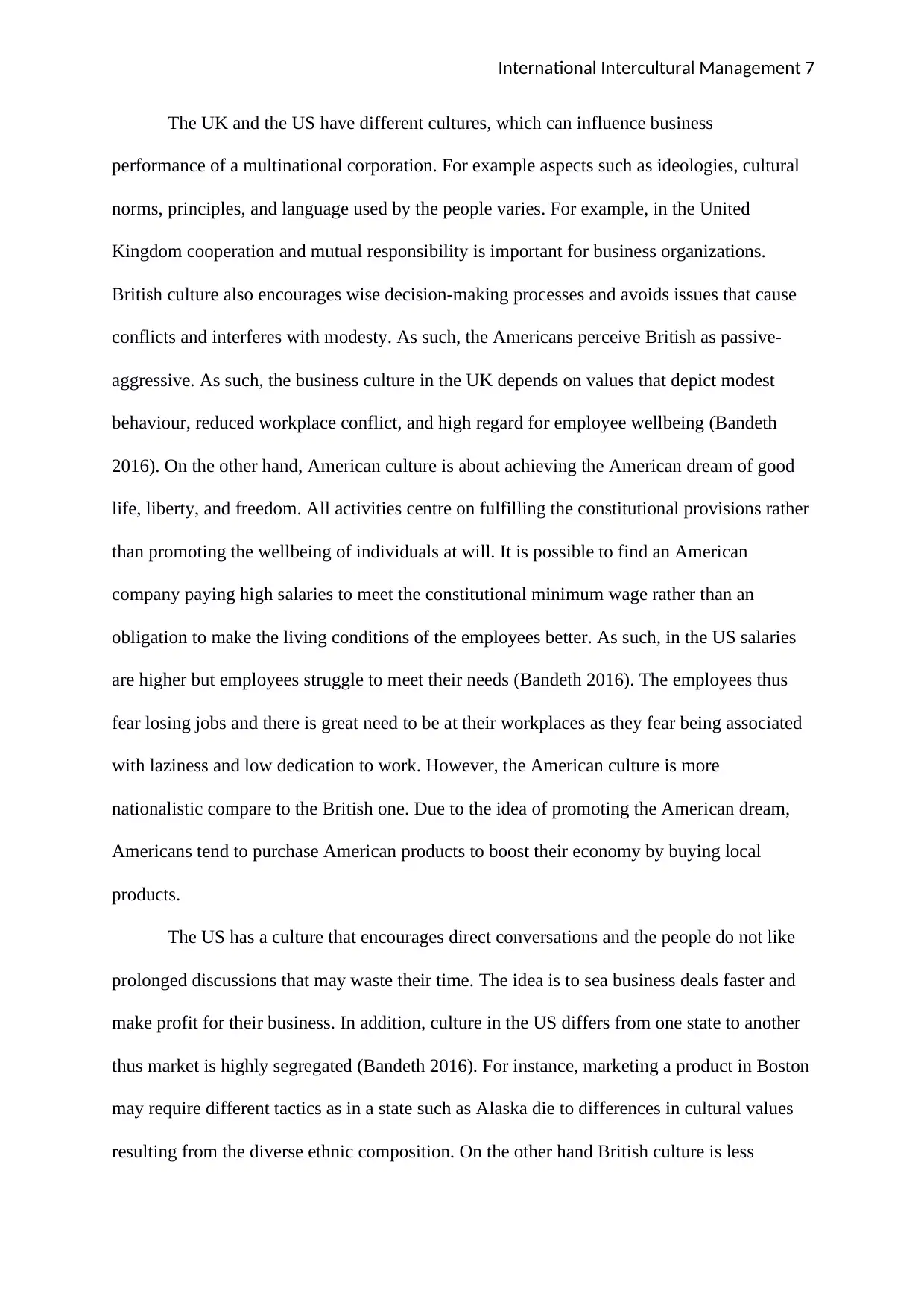
International Intercultural Management 7
The UK and the US have different cultures, which can influence business
performance of a multinational corporation. For example aspects such as ideologies, cultural
norms, principles, and language used by the people varies. For example, in the United
Kingdom cooperation and mutual responsibility is important for business organizations.
British culture also encourages wise decision-making processes and avoids issues that cause
conflicts and interferes with modesty. As such, the Americans perceive British as passive-
aggressive. As such, the business culture in the UK depends on values that depict modest
behaviour, reduced workplace conflict, and high regard for employee wellbeing (Bandeth
2016). On the other hand, American culture is about achieving the American dream of good
life, liberty, and freedom. All activities centre on fulfilling the constitutional provisions rather
than promoting the wellbeing of individuals at will. It is possible to find an American
company paying high salaries to meet the constitutional minimum wage rather than an
obligation to make the living conditions of the employees better. As such, in the US salaries
are higher but employees struggle to meet their needs (Bandeth 2016). The employees thus
fear losing jobs and there is great need to be at their workplaces as they fear being associated
with laziness and low dedication to work. However, the American culture is more
nationalistic compare to the British one. Due to the idea of promoting the American dream,
Americans tend to purchase American products to boost their economy by buying local
products.
The US has a culture that encourages direct conversations and the people do not like
prolonged discussions that may waste their time. The idea is to sea business deals faster and
make profit for their business. In addition, culture in the US differs from one state to another
thus market is highly segregated (Bandeth 2016). For instance, marketing a product in Boston
may require different tactics as in a state such as Alaska die to differences in cultural values
resulting from the diverse ethnic composition. On the other hand British culture is less
The UK and the US have different cultures, which can influence business
performance of a multinational corporation. For example aspects such as ideologies, cultural
norms, principles, and language used by the people varies. For example, in the United
Kingdom cooperation and mutual responsibility is important for business organizations.
British culture also encourages wise decision-making processes and avoids issues that cause
conflicts and interferes with modesty. As such, the Americans perceive British as passive-
aggressive. As such, the business culture in the UK depends on values that depict modest
behaviour, reduced workplace conflict, and high regard for employee wellbeing (Bandeth
2016). On the other hand, American culture is about achieving the American dream of good
life, liberty, and freedom. All activities centre on fulfilling the constitutional provisions rather
than promoting the wellbeing of individuals at will. It is possible to find an American
company paying high salaries to meet the constitutional minimum wage rather than an
obligation to make the living conditions of the employees better. As such, in the US salaries
are higher but employees struggle to meet their needs (Bandeth 2016). The employees thus
fear losing jobs and there is great need to be at their workplaces as they fear being associated
with laziness and low dedication to work. However, the American culture is more
nationalistic compare to the British one. Due to the idea of promoting the American dream,
Americans tend to purchase American products to boost their economy by buying local
products.
The US has a culture that encourages direct conversations and the people do not like
prolonged discussions that may waste their time. The idea is to sea business deals faster and
make profit for their business. In addition, culture in the US differs from one state to another
thus market is highly segregated (Bandeth 2016). For instance, marketing a product in Boston
may require different tactics as in a state such as Alaska die to differences in cultural values
resulting from the diverse ethnic composition. On the other hand British culture is less
Paraphrase This Document
Need a fresh take? Get an instant paraphrase of this document with our AI Paraphraser
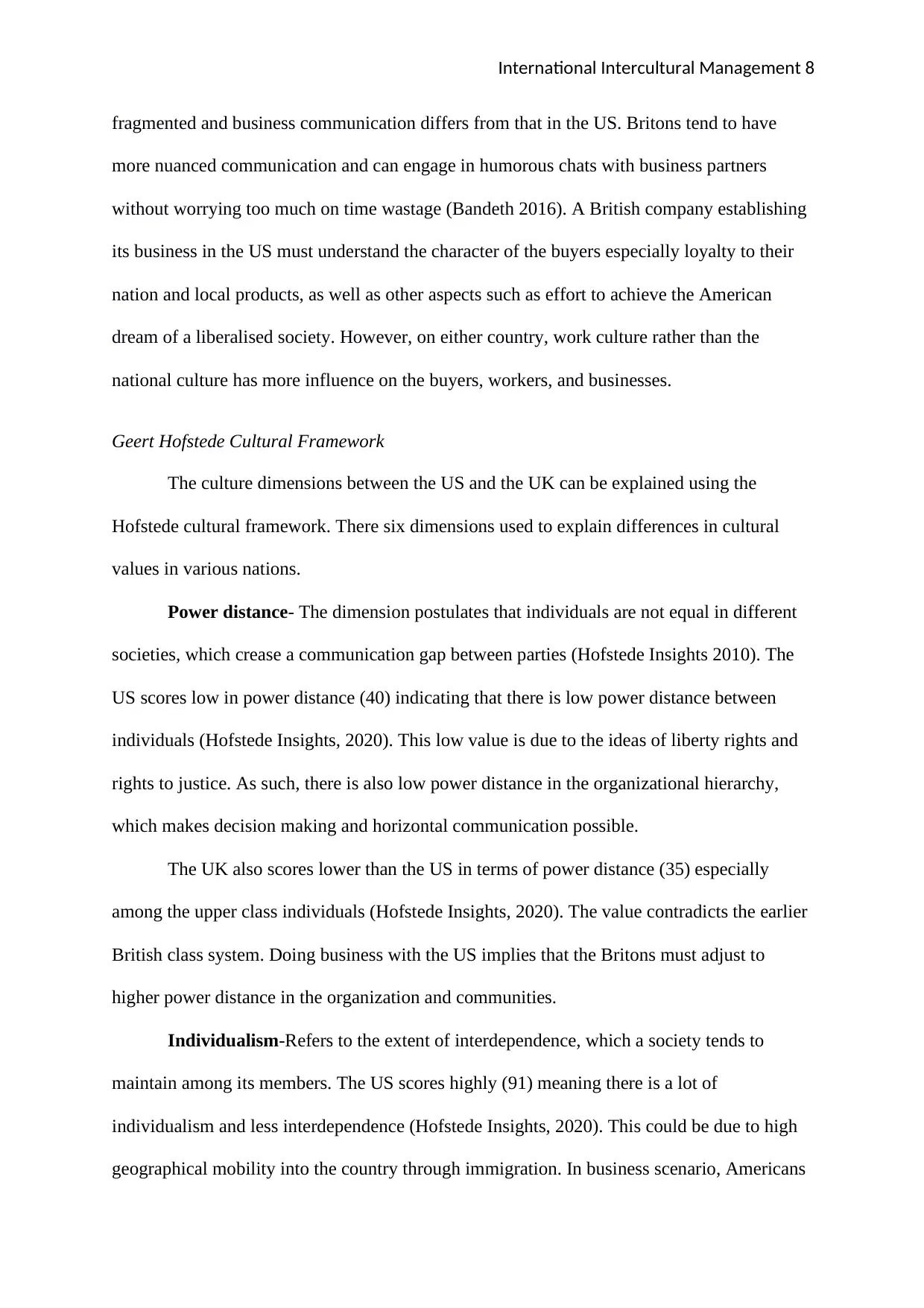
International Intercultural Management 8
fragmented and business communication differs from that in the US. Britons tend to have
more nuanced communication and can engage in humorous chats with business partners
without worrying too much on time wastage (Bandeth 2016). A British company establishing
its business in the US must understand the character of the buyers especially loyalty to their
nation and local products, as well as other aspects such as effort to achieve the American
dream of a liberalised society. However, on either country, work culture rather than the
national culture has more influence on the buyers, workers, and businesses.
Geert Hofstede Cultural Framework
The culture dimensions between the US and the UK can be explained using the
Hofstede cultural framework. There six dimensions used to explain differences in cultural
values in various nations.
Power distance- The dimension postulates that individuals are not equal in different
societies, which crease a communication gap between parties (Hofstede Insights 2010). The
US scores low in power distance (40) indicating that there is low power distance between
individuals (Hofstede Insights, 2020). This low value is due to the ideas of liberty rights and
rights to justice. As such, there is also low power distance in the organizational hierarchy,
which makes decision making and horizontal communication possible.
The UK also scores lower than the US in terms of power distance (35) especially
among the upper class individuals (Hofstede Insights, 2020). The value contradicts the earlier
British class system. Doing business with the US implies that the Britons must adjust to
higher power distance in the organization and communities.
Individualism-Refers to the extent of interdependence, which a society tends to
maintain among its members. The US scores highly (91) meaning there is a lot of
individualism and less interdependence (Hofstede Insights, 2020). This could be due to high
geographical mobility into the country through immigration. In business scenario, Americans
fragmented and business communication differs from that in the US. Britons tend to have
more nuanced communication and can engage in humorous chats with business partners
without worrying too much on time wastage (Bandeth 2016). A British company establishing
its business in the US must understand the character of the buyers especially loyalty to their
nation and local products, as well as other aspects such as effort to achieve the American
dream of a liberalised society. However, on either country, work culture rather than the
national culture has more influence on the buyers, workers, and businesses.
Geert Hofstede Cultural Framework
The culture dimensions between the US and the UK can be explained using the
Hofstede cultural framework. There six dimensions used to explain differences in cultural
values in various nations.
Power distance- The dimension postulates that individuals are not equal in different
societies, which crease a communication gap between parties (Hofstede Insights 2010). The
US scores low in power distance (40) indicating that there is low power distance between
individuals (Hofstede Insights, 2020). This low value is due to the ideas of liberty rights and
rights to justice. As such, there is also low power distance in the organizational hierarchy,
which makes decision making and horizontal communication possible.
The UK also scores lower than the US in terms of power distance (35) especially
among the upper class individuals (Hofstede Insights, 2020). The value contradicts the earlier
British class system. Doing business with the US implies that the Britons must adjust to
higher power distance in the organization and communities.
Individualism-Refers to the extent of interdependence, which a society tends to
maintain among its members. The US scores highly (91) meaning there is a lot of
individualism and less interdependence (Hofstede Insights, 2020). This could be due to high
geographical mobility into the country through immigration. In business scenario, Americans
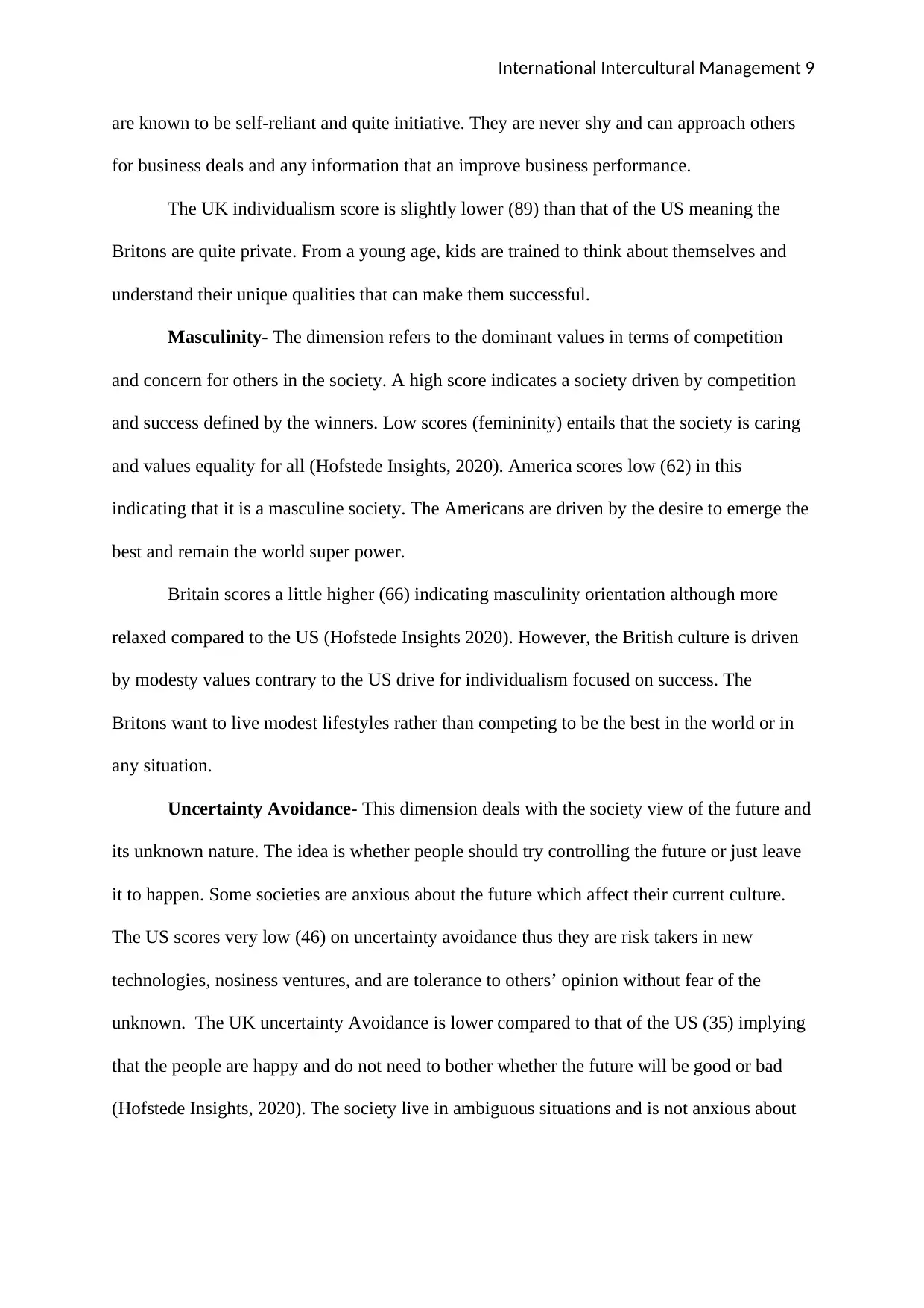
International Intercultural Management 9
are known to be self-reliant and quite initiative. They are never shy and can approach others
for business deals and any information that an improve business performance.
The UK individualism score is slightly lower (89) than that of the US meaning the
Britons are quite private. From a young age, kids are trained to think about themselves and
understand their unique qualities that can make them successful.
Masculinity- The dimension refers to the dominant values in terms of competition
and concern for others in the society. A high score indicates a society driven by competition
and success defined by the winners. Low scores (femininity) entails that the society is caring
and values equality for all (Hofstede Insights, 2020). America scores low (62) in this
indicating that it is a masculine society. The Americans are driven by the desire to emerge the
best and remain the world super power.
Britain scores a little higher (66) indicating masculinity orientation although more
relaxed compared to the US (Hofstede Insights 2020). However, the British culture is driven
by modesty values contrary to the US drive for individualism focused on success. The
Britons want to live modest lifestyles rather than competing to be the best in the world or in
any situation.
Uncertainty Avoidance- This dimension deals with the society view of the future and
its unknown nature. The idea is whether people should try controlling the future or just leave
it to happen. Some societies are anxious about the future which affect their current culture.
The US scores very low (46) on uncertainty avoidance thus they are risk takers in new
technologies, nosiness ventures, and are tolerance to others’ opinion without fear of the
unknown. The UK uncertainty Avoidance is lower compared to that of the US (35) implying
that the people are happy and do not need to bother whether the future will be good or bad
(Hofstede Insights, 2020). The society live in ambiguous situations and is not anxious about
are known to be self-reliant and quite initiative. They are never shy and can approach others
for business deals and any information that an improve business performance.
The UK individualism score is slightly lower (89) than that of the US meaning the
Britons are quite private. From a young age, kids are trained to think about themselves and
understand their unique qualities that can make them successful.
Masculinity- The dimension refers to the dominant values in terms of competition
and concern for others in the society. A high score indicates a society driven by competition
and success defined by the winners. Low scores (femininity) entails that the society is caring
and values equality for all (Hofstede Insights, 2020). America scores low (62) in this
indicating that it is a masculine society. The Americans are driven by the desire to emerge the
best and remain the world super power.
Britain scores a little higher (66) indicating masculinity orientation although more
relaxed compared to the US (Hofstede Insights 2020). However, the British culture is driven
by modesty values contrary to the US drive for individualism focused on success. The
Britons want to live modest lifestyles rather than competing to be the best in the world or in
any situation.
Uncertainty Avoidance- This dimension deals with the society view of the future and
its unknown nature. The idea is whether people should try controlling the future or just leave
it to happen. Some societies are anxious about the future which affect their current culture.
The US scores very low (46) on uncertainty avoidance thus they are risk takers in new
technologies, nosiness ventures, and are tolerance to others’ opinion without fear of the
unknown. The UK uncertainty Avoidance is lower compared to that of the US (35) implying
that the people are happy and do not need to bother whether the future will be good or bad
(Hofstede Insights, 2020). The society live in ambiguous situations and is not anxious about
⊘ This is a preview!⊘
Do you want full access?
Subscribe today to unlock all pages.

Trusted by 1+ million students worldwide
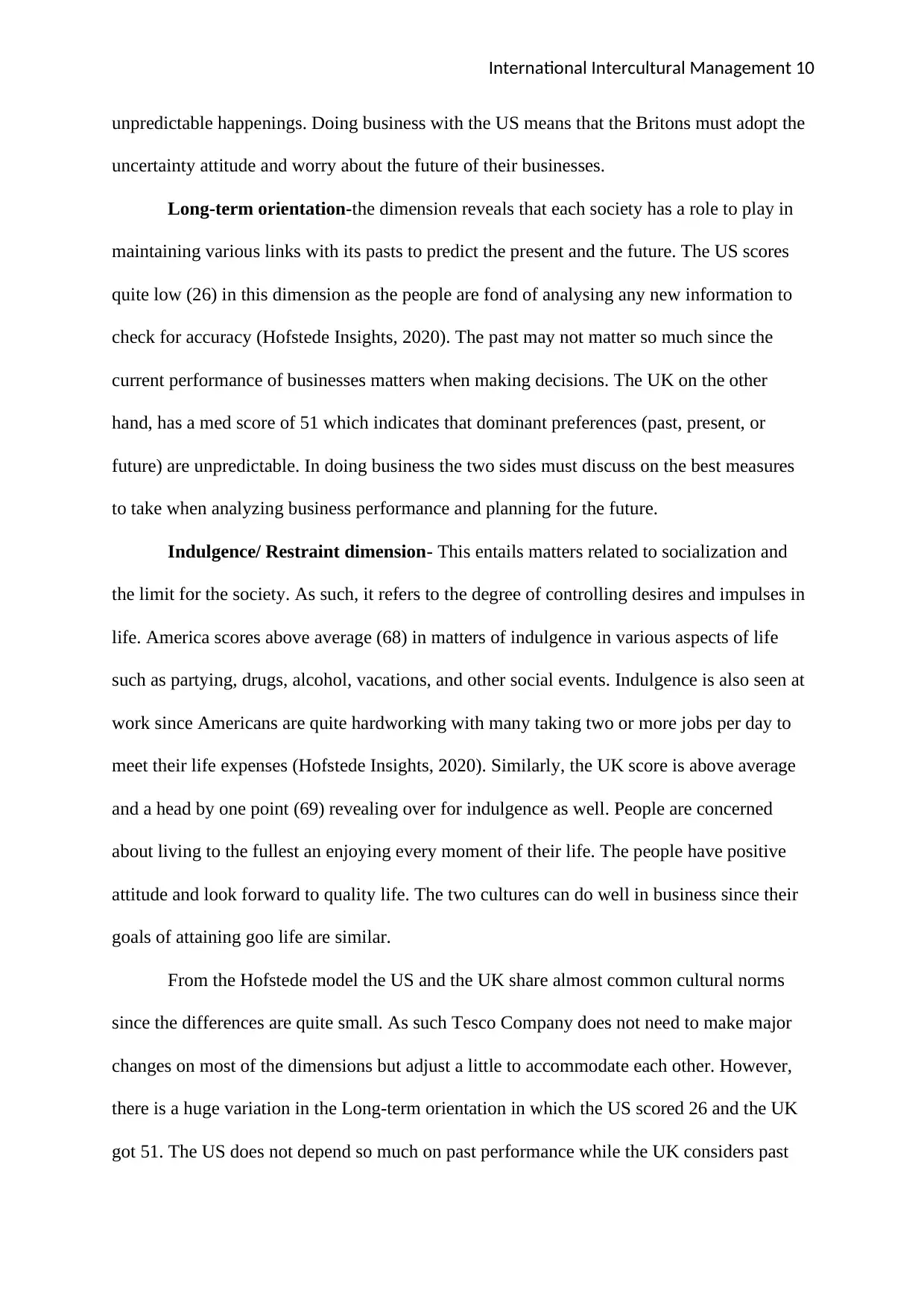
International Intercultural Management 10
unpredictable happenings. Doing business with the US means that the Britons must adopt the
uncertainty attitude and worry about the future of their businesses.
Long-term orientation-the dimension reveals that each society has a role to play in
maintaining various links with its pasts to predict the present and the future. The US scores
quite low (26) in this dimension as the people are fond of analysing any new information to
check for accuracy (Hofstede Insights, 2020). The past may not matter so much since the
current performance of businesses matters when making decisions. The UK on the other
hand, has a med score of 51 which indicates that dominant preferences (past, present, or
future) are unpredictable. In doing business the two sides must discuss on the best measures
to take when analyzing business performance and planning for the future.
Indulgence/ Restraint dimension- This entails matters related to socialization and
the limit for the society. As such, it refers to the degree of controlling desires and impulses in
life. America scores above average (68) in matters of indulgence in various aspects of life
such as partying, drugs, alcohol, vacations, and other social events. Indulgence is also seen at
work since Americans are quite hardworking with many taking two or more jobs per day to
meet their life expenses (Hofstede Insights, 2020). Similarly, the UK score is above average
and a head by one point (69) revealing over for indulgence as well. People are concerned
about living to the fullest an enjoying every moment of their life. The people have positive
attitude and look forward to quality life. The two cultures can do well in business since their
goals of attaining goo life are similar.
From the Hofstede model the US and the UK share almost common cultural norms
since the differences are quite small. As such Tesco Company does not need to make major
changes on most of the dimensions but adjust a little to accommodate each other. However,
there is a huge variation in the Long-term orientation in which the US scored 26 and the UK
got 51. The US does not depend so much on past performance while the UK considers past
unpredictable happenings. Doing business with the US means that the Britons must adopt the
uncertainty attitude and worry about the future of their businesses.
Long-term orientation-the dimension reveals that each society has a role to play in
maintaining various links with its pasts to predict the present and the future. The US scores
quite low (26) in this dimension as the people are fond of analysing any new information to
check for accuracy (Hofstede Insights, 2020). The past may not matter so much since the
current performance of businesses matters when making decisions. The UK on the other
hand, has a med score of 51 which indicates that dominant preferences (past, present, or
future) are unpredictable. In doing business the two sides must discuss on the best measures
to take when analyzing business performance and planning for the future.
Indulgence/ Restraint dimension- This entails matters related to socialization and
the limit for the society. As such, it refers to the degree of controlling desires and impulses in
life. America scores above average (68) in matters of indulgence in various aspects of life
such as partying, drugs, alcohol, vacations, and other social events. Indulgence is also seen at
work since Americans are quite hardworking with many taking two or more jobs per day to
meet their life expenses (Hofstede Insights, 2020). Similarly, the UK score is above average
and a head by one point (69) revealing over for indulgence as well. People are concerned
about living to the fullest an enjoying every moment of their life. The people have positive
attitude and look forward to quality life. The two cultures can do well in business since their
goals of attaining goo life are similar.
From the Hofstede model the US and the UK share almost common cultural norms
since the differences are quite small. As such Tesco Company does not need to make major
changes on most of the dimensions but adjust a little to accommodate each other. However,
there is a huge variation in the Long-term orientation in which the US scored 26 and the UK
got 51. The US does not depend so much on past performance while the UK considers past
Paraphrase This Document
Need a fresh take? Get an instant paraphrase of this document with our AI Paraphraser
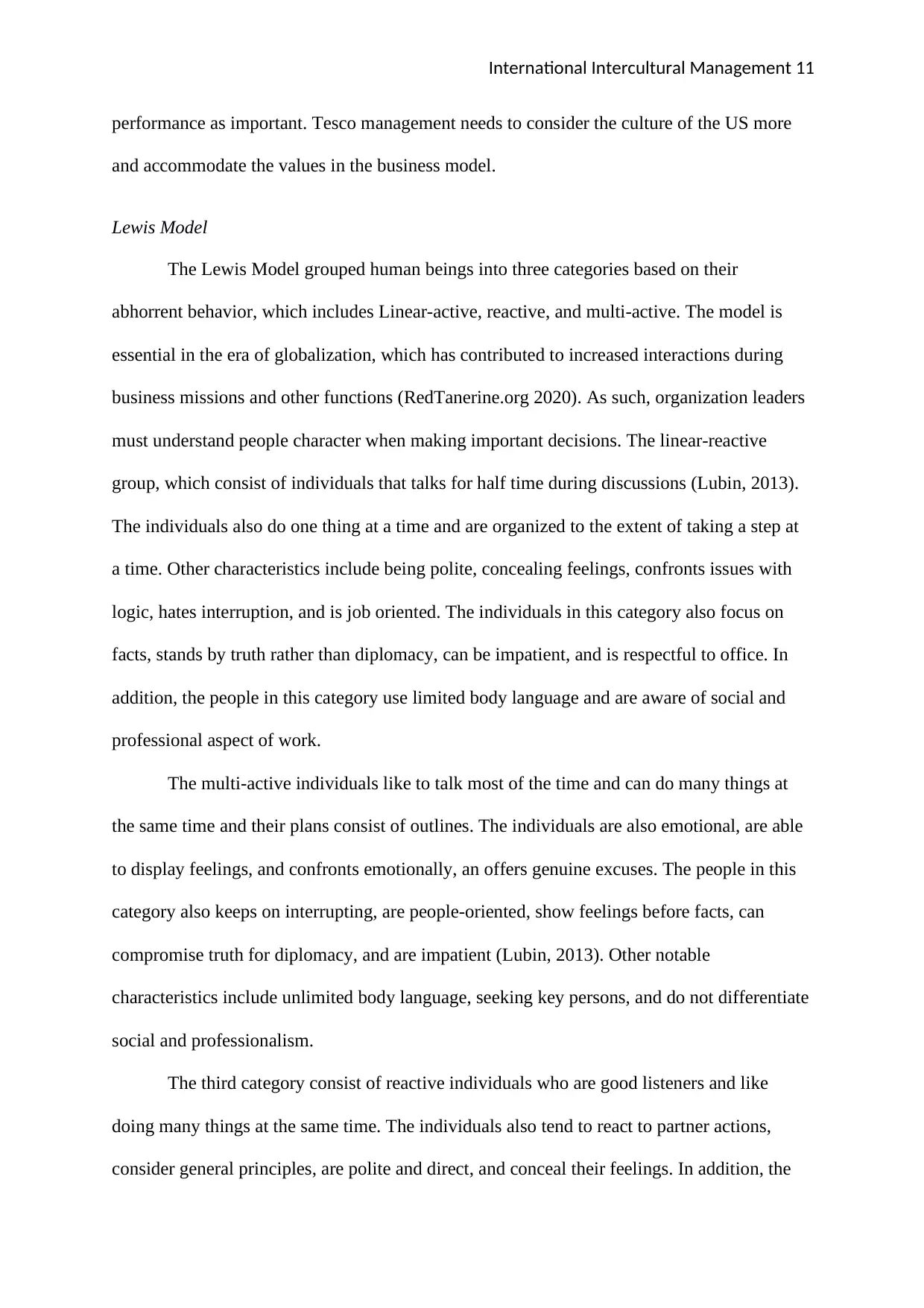
International Intercultural Management 11
performance as important. Tesco management needs to consider the culture of the US more
and accommodate the values in the business model.
Lewis Model
The Lewis Model grouped human beings into three categories based on their
abhorrent behavior, which includes Linear-active, reactive, and multi-active. The model is
essential in the era of globalization, which has contributed to increased interactions during
business missions and other functions (RedTanerine.org 2020). As such, organization leaders
must understand people character when making important decisions. The linear-reactive
group, which consist of individuals that talks for half time during discussions (Lubin, 2013).
The individuals also do one thing at a time and are organized to the extent of taking a step at
a time. Other characteristics include being polite, concealing feelings, confronts issues with
logic, hates interruption, and is job oriented. The individuals in this category also focus on
facts, stands by truth rather than diplomacy, can be impatient, and is respectful to office. In
addition, the people in this category use limited body language and are aware of social and
professional aspect of work.
The multi-active individuals like to talk most of the time and can do many things at
the same time and their plans consist of outlines. The individuals are also emotional, are able
to display feelings, and confronts emotionally, an offers genuine excuses. The people in this
category also keeps on interrupting, are people-oriented, show feelings before facts, can
compromise truth for diplomacy, and are impatient (Lubin, 2013). Other notable
characteristics include unlimited body language, seeking key persons, and do not differentiate
social and professionalism.
The third category consist of reactive individuals who are good listeners and like
doing many things at the same time. The individuals also tend to react to partner actions,
consider general principles, are polite and direct, and conceal their feelings. In addition, the
performance as important. Tesco management needs to consider the culture of the US more
and accommodate the values in the business model.
Lewis Model
The Lewis Model grouped human beings into three categories based on their
abhorrent behavior, which includes Linear-active, reactive, and multi-active. The model is
essential in the era of globalization, which has contributed to increased interactions during
business missions and other functions (RedTanerine.org 2020). As such, organization leaders
must understand people character when making important decisions. The linear-reactive
group, which consist of individuals that talks for half time during discussions (Lubin, 2013).
The individuals also do one thing at a time and are organized to the extent of taking a step at
a time. Other characteristics include being polite, concealing feelings, confronts issues with
logic, hates interruption, and is job oriented. The individuals in this category also focus on
facts, stands by truth rather than diplomacy, can be impatient, and is respectful to office. In
addition, the people in this category use limited body language and are aware of social and
professional aspect of work.
The multi-active individuals like to talk most of the time and can do many things at
the same time and their plans consist of outlines. The individuals are also emotional, are able
to display feelings, and confronts emotionally, an offers genuine excuses. The people in this
category also keeps on interrupting, are people-oriented, show feelings before facts, can
compromise truth for diplomacy, and are impatient (Lubin, 2013). Other notable
characteristics include unlimited body language, seeking key persons, and do not differentiate
social and professionalism.
The third category consist of reactive individuals who are good listeners and like
doing many things at the same time. The individuals also tend to react to partner actions,
consider general principles, are polite and direct, and conceal their feelings. In addition, the
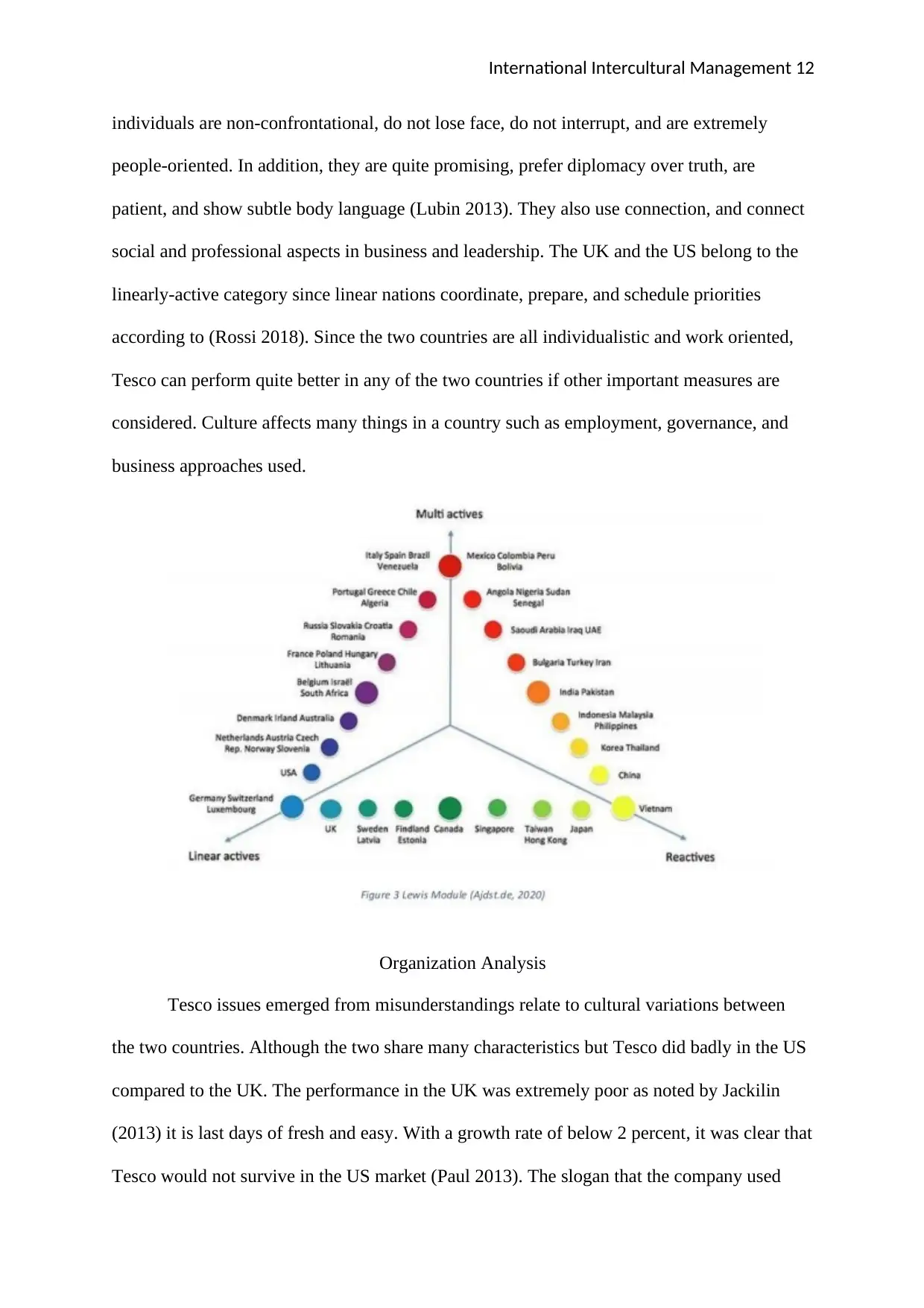
International Intercultural Management 12
individuals are non-confrontational, do not lose face, do not interrupt, and are extremely
people-oriented. In addition, they are quite promising, prefer diplomacy over truth, are
patient, and show subtle body language (Lubin 2013). They also use connection, and connect
social and professional aspects in business and leadership. The UK and the US belong to the
linearly-active category since linear nations coordinate, prepare, and schedule priorities
according to (Rossi 2018). Since the two countries are all individualistic and work oriented,
Tesco can perform quite better in any of the two countries if other important measures are
considered. Culture affects many things in a country such as employment, governance, and
business approaches used.
Organization Analysis
Tesco issues emerged from misunderstandings relate to cultural variations between
the two countries. Although the two share many characteristics but Tesco did badly in the US
compared to the UK. The performance in the UK was extremely poor as noted by Jackilin
(2013) it is last days of fresh and easy. With a growth rate of below 2 percent, it was clear that
Tesco would not survive in the US market (Paul 2013). The slogan that the company used
individuals are non-confrontational, do not lose face, do not interrupt, and are extremely
people-oriented. In addition, they are quite promising, prefer diplomacy over truth, are
patient, and show subtle body language (Lubin 2013). They also use connection, and connect
social and professional aspects in business and leadership. The UK and the US belong to the
linearly-active category since linear nations coordinate, prepare, and schedule priorities
according to (Rossi 2018). Since the two countries are all individualistic and work oriented,
Tesco can perform quite better in any of the two countries if other important measures are
considered. Culture affects many things in a country such as employment, governance, and
business approaches used.
Organization Analysis
Tesco issues emerged from misunderstandings relate to cultural variations between
the two countries. Although the two share many characteristics but Tesco did badly in the US
compared to the UK. The performance in the UK was extremely poor as noted by Jackilin
(2013) it is last days of fresh and easy. With a growth rate of below 2 percent, it was clear that
Tesco would not survive in the US market (Paul 2013). The slogan that the company used
⊘ This is a preview!⊘
Do you want full access?
Subscribe today to unlock all pages.

Trusted by 1+ million students worldwide
1 out of 18
Related Documents
Your All-in-One AI-Powered Toolkit for Academic Success.
+13062052269
info@desklib.com
Available 24*7 on WhatsApp / Email
![[object Object]](/_next/static/media/star-bottom.7253800d.svg)
Unlock your academic potential
Copyright © 2020–2025 A2Z Services. All Rights Reserved. Developed and managed by ZUCOL.





